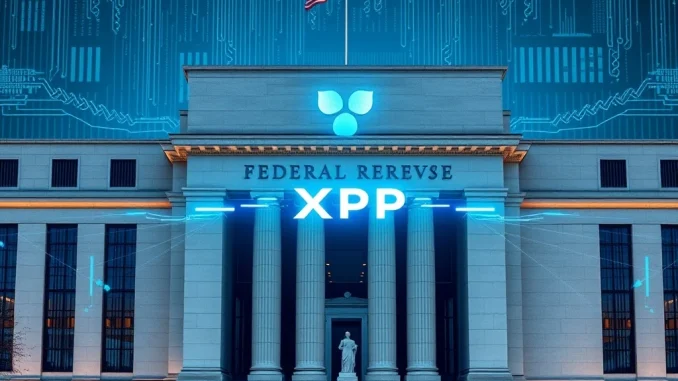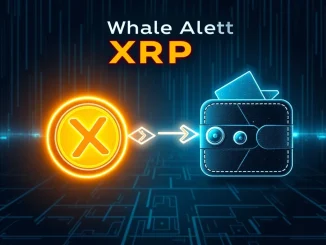
The cryptocurrency world is buzzing with anticipation as Ripple, the company behind the digital asset XRP, pushes forward in its quest for a U.S. banking license. This isn’t just a routine regulatory hurdle; it’s a strategic move that could fundamentally reshape Ripple’s role in the global financial landscape. Recent insights from Federal Reserve documents reveal a fascinating path that could potentially fast-track this crucial approval, thanks to a combination of structured review processes and an unexpected emergency clause. For anyone invested in the future of digital finance, understanding this Ripple banking license journey is key.
The Quest for a Ripple Banking License: A Strategic Imperative
Ripple’s ambition to secure a national trust charter in the U.S. signals a profound commitment to integrating its blockchain-based solutions within traditional financial systems. This isn’t merely about expanding services; it’s about gaining the regulatory clarity and operational legitimacy necessary to truly revolutionize cross-border payments. A U.S. banking license would:
- Enhance trust and credibility with traditional financial institutions.
- Open doors to new partnerships and services requiring a licensed entity.
- Provide a robust regulatory framework for its operations, potentially mitigating future legal challenges.
- Solidify its position as a bridge between conventional finance and the burgeoning digital asset economy.
Decoding the Federal Reserve Review: Timelines and Flexibility
At the heart of Ripple’s application process lies the Federal Reserve’s rigorous review mechanism, specifically outlined in 12 CFR § 262.3. This regulation typically mandates a 90-day review period following public notice of an application. During this critical window, the Federal Reserve or a Reserve Bank must either approve, deny, or request re-publication of the application. This period is designed for:
- Public Comment: Allowing stakeholders and the public to submit their views.
- Internal Evaluation: The Fed assesses the application against strict criteria, including financial soundness, management capabilities, and potential impact on the financial system.
- Interagency Coordination: Often, this process involves coordination with other key regulatory bodies like the Securities and Exchange Commission (SEC) and the Office of the Comptroller of the Currency (OCC), especially for an entity like Ripple that straddles traditional finance and digital assets.
While 90 days might seem straightforward, the Fed retains considerable discretion to adjust this timeline. This flexibility is crucial, as noted by X user Mr. Man, who has extensively analyzed these documents. The timeline can be expedited or extended based on various factors, including the complexity of the application or the need for deeper interagency dialogue. This adaptive approach highlights the Fed’s capacity to balance regulatory thoroughness with strategic expediency during a Federal Reserve review.
Navigating the XRP Regulatory Path: Beyond the 90 Days
Beyond the initial review, the path to a fully operational banking charter involves additional, federally mandated deadlines designed to ensure approved entities become active participants in the financial system. For Ripple, these deadlines are particularly important:
- Three-Month Transaction Window: Any approved application must culminate in a transaction within three months of approval. This ensures that the granted charter is promptly utilized.
- Six-Month Operational Launch: If the charter involves acquiring stock in a newly formed bank, as is likely in Ripple’s scenario, the new entity must commence operations within six months of the consummation of the acquisition.
These deadlines prevent the creation of “dormant” institutions. However, the regulations also include provisions for extensions in cases of “good cause.” This offers Ripple a vital safety net, providing flexibility to address unforeseen operational challenges or complex integration requirements without jeopardizing its hard-won approval. Understanding this intricate XRP regulatory path is vital for predicting Ripple’s future trajectory.
The Power of the Emergency Clause: Fast-Tracking Your US Banking Charter
Perhaps the most intriguing aspect of the Federal Reserve’s regulatory framework, and a potential game-changer for Ripple, is the emergency clause. This powerful provision permits the Fed to bypass standard procedural requirements entirely when:
- An emergency exists.
- Immediate action is necessary to prevent the failure of a financial institution.
- Such action is in the public interest.
Highlighted by Mr. Man’s analysis, this emergency power acts as a legal fast track. It means the Fed could potentially approve Ripple’s national trust charter without the usual notice periods or extensive public comment if it deems such immediate action critical for financial stability or technological interoperability. Given Ripple’s extensive partnerships with over 70 central banks and its growing influence in cross-border payments, its role in bridging traditional and blockchain-based systems could indeed be deemed systemically important. This could significantly shorten the overall timeline for securing a US banking charter.
Ripple’s Impact on Blockchain Payments: A Systemic Role
Ripple’s pursuit of a U.S. banking license isn’t just about its own growth; it has broader implications for the future of blockchain payments and digital asset infrastructure globally. Its existing network and partnerships underscore its strategic value. If regulators view Ripple as a crucial component for modernizing payment systems and enhancing financial stability, especially in a competitive global landscape, the likelihood of leveraging the emergency clause increases.
The Fed’s framework demonstrates a delicate balance: regulatory rigor ensures stability, while adaptability allows for innovation. For Ripple, this means success hinges not only on meeting procedural milestones but also on effectively communicating its strategic contributions to digital finance, potentially positioning itself as an essential player whose rapid integration serves the public interest.
Summary: A Pivotal Moment for Ripple
Ripple’s journey to securing a U.S. banking license is a fascinating case study in regulatory navigation within the evolving digital finance landscape. While a typical path might span up to nine months, the Federal Reserve’s flexible 90-day review and, crucially, its emergency clause, offer a compelling avenue for accelerated approval. This potential fast-track underscores Ripple’s growing importance in global payments and signals how U.S. authorities might adapt to integrate transformative blockchain technologies. The ultimate timeline will depend on a blend of procedural adherence and strategic recognition of Ripple’s pivotal role in shaping the future of finance.
Frequently Asked Questions (FAQs)
Q1: What is a national trust charter and why is Ripple pursuing it?
A national trust charter is a type of banking license that allows an entity to offer trust services, which can include acting as a fiduciary, managing assets, and facilitating financial transactions. Ripple is pursuing it to gain regulatory clarity, enhance credibility with traditional financial institutions, and expand its services within a regulated framework, particularly for its cross-border payment solutions.
Q2: How long does the Federal Reserve’s review process typically take for a banking license?
Under normal circumstances, the Federal Reserve’s review process for a national trust charter application involves a 90-day public notice period. Including subsequent operational readiness deadlines, the entire process from public notice to operational launch could take up to nine months.
Q3: What is the “emergency clause” and how could it benefit Ripple?
The “emergency clause” in Federal Reserve regulations allows the Fed to bypass standard procedural requirements, including notice periods, when an emergency exists or immediate action is necessary to prevent failure or serve the public interest. For Ripple, this means its banking charter could potentially be approved much faster if the Fed deems its role in financial stability or technological interoperability to be critical.
Q4: What role do other agencies like the SEC and OCC play in Ripple’s application?
The Federal Reserve often coordinates with other regulatory bodies such as the Securities and Exchange Commission (SEC) and the Office of the Comptroller of the Currency (OCC) when reviewing applications, especially for entities like Ripple that operate at the intersection of traditional finance and digital assets. This interagency coordination ensures a comprehensive regulatory assessment.
Q5: How does Ripple’s global presence impact its U.S. banking license application?
Ripple’s extensive partnerships with over 70 central banks and its significant role in global cross-border payments highlight its strategic value. This global influence could be a factor in the Federal Reserve’s decision-making, potentially leading them to prioritize or expedite Ripple’s application if its contributions are seen as vital for systemic stability and modernizing payment infrastructure.
Q6: What happens if Ripple’s application is approved?
If approved, federal rules mandate that Ripple must engage in a transaction within three months and, if acquiring stock in a newly formed bank, launch operations within six months of consummation. These deadlines ensure the approved entity becomes active, though provisions for extensions exist for “good cause.”



